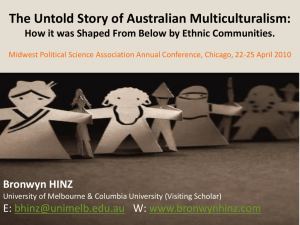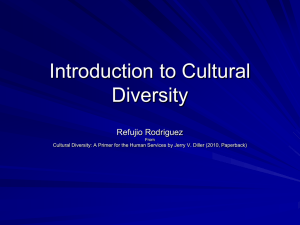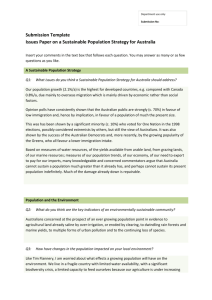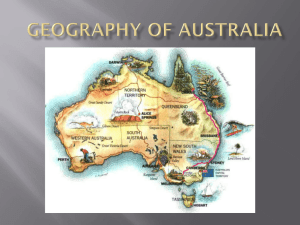CALD (culturally and linguistically diverse)
advertisement
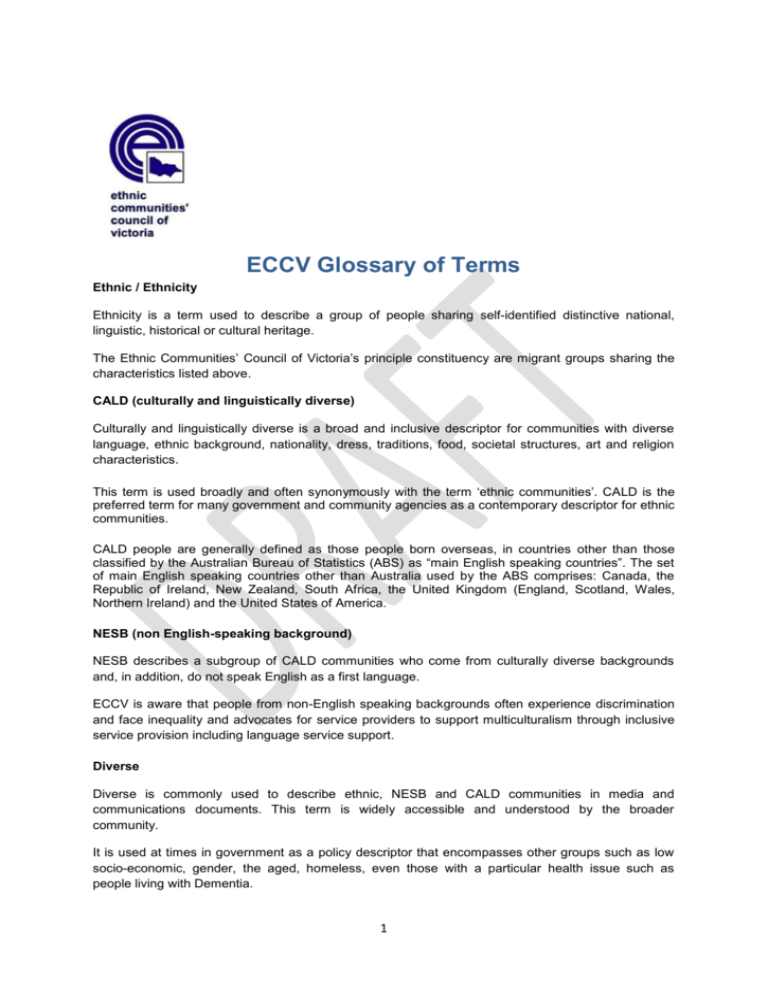
ECCV Glossary of Terms Ethnic / Ethnicity Ethnicity is a term used to describe a group of people sharing self-identified distinctive national, linguistic, historical or cultural heritage. The Ethnic Communities’ Council of Victoria’s principle constituency are migrant groups sharing the characteristics listed above. CALD (culturally and linguistically diverse) Culturally and linguistically diverse is a broad and inclusive descriptor for communities with diverse language, ethnic background, nationality, dress, traditions, food, societal structures, art and religion characteristics. This term is used broadly and often synonymously with the term ‘ethnic communities’. CALD is the preferred term for many government and community agencies as a contemporary descriptor for ethnic communities. CALD people are generally defined as those people born overseas, in countries other than those classified by the Australian Bureau of Statistics (ABS) as “main English speaking countries”. The set of main English speaking countries other than Australia used by the ABS comprises: Canada, the Republic of Ireland, New Zealand, South Africa, the United Kingdom (England, Scotland, Wales, Northern Ireland) and the United States of America. NESB (non English-speaking background) NESB describes a subgroup of CALD communities who come from culturally diverse backgrounds and, in addition, do not speak English as a first language. ECCV is aware that people from non-English speaking backgrounds often experience discrimination and face inequality and advocates for service providers to support multiculturalism through inclusive service provision including language service support. Diverse Diverse is commonly used to describe ethnic, NESB and CALD communities in media and communications documents. This term is widely accessible and understood by the broader community. It is used at times in government as a policy descriptor that encompasses other groups such as low socio-economic, gender, the aged, homeless, even those with a particular health issue such as people living with Dementia. 1 In ECCV documents, the term diverse is used in the context of CALD communities and in general does not describe other types of diversity. Multiculturalism Multiculturalism is a demographic descriptor, a culturally inclusive ideology and a Federal and State Government policy. Victoria has a multicultural (or ‘many cultures’) demography. It has one of the world's most culturally and linguistically diverse communities with over 40 per cent of Victorians born overseas or having at least one parent born overseas. As an ideology, multiculturalism recognises the values and benefits of cultural diversity for all Australians, within the broader aims of national unity, community harmony and maintenance of democratic values. Multiculturalism promotes a just, inclusive and socially cohesive society, where services are responsive to the needs of Australians from culturally and linguistically diverse backgrounds. Multiculturalism was introduced by the Federal Government as a policy in 1972. The Federal Government’s commitment to this policy was reconfirmed with the launch of The People of Australia – Australia's Multicultural Policy in February 2011 by the Minister for Immigration and Citizenship, the Hon Chris Bowen MP. Source: The People of Australia – Australia's Multicultural Policy Recently-arrived ECCV acknowledges that apart from indigenous Australians, all Australians trace their linage to a migration journey. Migrant groups are often characterized by their length of residency in Australia for the purposes of service provision and policy planning. This term is generally used as a relative descriptor when describing migration in relation to time. The term recently-arrived is generally used to identify migrant and refugee groups still in need of additional support. The Department of Immigration & Citizenship defines ‘recently arrived’ as up to 5 years in Australia. ECCV uses the term recently-arrived to describe communities consisting of first and second generation migrants, refugees, asylum seekers and permanent residents who have been here for up to 10 years or individuals who have been here less than 5 years. These communities generally have culturally and linguistically specific service needs which, when addressed, facilitate their successful participation in Australian life. New and Emerging New and emerging communities are small in number, recently arrived and may have all or some of the following characteristics: ECCV defines new and emerging communities as those groups that: have recently settled in Australia are small in number but with a significant increase in the previous five years 2 lack sufficient infrastructure resources relative to established ethnic communities. 1 ECCV notes that people from new and emerging communities may experience some or all of the following2: lack established family networks, support systems, community structures and resources, relative to more established communities are more vulnerable than established communities as they are often from a refugee background and have experienced displacement due to civil unrest have low levels of education and workforce skills due to displacement have limited English language skills are unfamiliar with mainstream government services that are available in Australia and are less likely to be able to locate services that can help them meet their basic needs experience employment and job advancement barriers face difficulties gaining recognition for overseas qualifications The term “New and Emerging” can be applied to these communities for time period of up to one generation, however, the needs of these communities can exceed this period. Established communities Established communities have generally been resident in Australia between one to two generations or more. They are varied in size and service needs, but generally have a greater need for aged care support than newer communities. They may have all or some of the following characteristics: - Long-term resident communities, particular migrants arriving in the post WWII and Vietnam (American) War periods. Well established independent and interdependent infrastructure and resources Significant networks of family support, particularly networks of a number of generations Often from a refugee background and have experienced racism either in country of origin or after arrival in Australia Include high rates of second generation education and life success Include individuals with low levels of education and skill due to displacement Include individuals who do not have English language skills through to individuals with native English skills Include individuals who need aged care facilities and support Include ‘second wave’ migrant groups arriving in Australia during different time periods Experience community identity challenges related to inter-generational differences and ‘second wave’ group differences Have developed sense of community identity as it relates to Australian identity Race Race is a term that is used in the public space to loosely describe individuals or groups with particular physical characteristics, religions, ethnic backgrounds, cultural customs, collective histories or countries of origin. 1 James Jupp AM, Defining New and Emerging Communities in Australian Mosaic Issue 24, March 2010 p10-12 and Policy Document FECCA New and Emerging Communities Policy Supporting New and Emerging Communities to Participate in and Contribute to Australian Society 2010 2 Adapted from FECCA New and Emerging Communities Policy Statement 2010 3 ECCV uses the term race in contexts where racism is being discussed. Racism occurs when individuals or groups are being discriminated against based on the characteristics listed above. As a term, race is problematic because it is an arbitrary socially constructed descriptor with no substantive basis in biology. ECCV understands that this term still has currency in Australian society. Racism Racism is discriminating against someone based on physical characteristics, descent or ancestry, nationality, religious belief, ethnicity, or ethnic origin. This includes bullying someone or discriminating against them ecause of a specific characteristic. In Victoria it is against the law to discriminate against someone because of their actual or assumed race - this is called racial discrimination. Source: Victorian Equal Opportunity and Human Rights Commission Boat people The term boat people is largely used in the public space to describe asylum seekers who arrive by sea. It is a term used to gain political advantage and has been adopted unthinkingly by some elements of the media. Asylum seekers are described by DIAC as Irregular Maritime Arrivals (IMA) and non-IMA (i.e. air arrival) asylum seekers who are legally seeking protection. ECCV uses the term asylum seeker when describing either air or sea arrivals and does not use the term boat people. Mainstream Mainstream is defined as a dominant cultural framework or group, often constructed by stories told through media outlets and dominant political narratives. ‘Mainstream culture’ is malleable, multidimensional and largely a constructed idea built in the public space. Australian mainstream culture has been largely defined by Anglo-Christian traditions and norms, although this culture is evolving. The mainstream can both include and exclude multicultural communities at different levels, depending on the access points and specific issues being discussed. While ‘mainstream’ culture can reflect general trends and power groups, this word should be avoided in ECCV publications as it is imprecise and encourages a constructed dichotomy between ‘mainstream’ and so –called ‘non-mainstream’. It is ECCV’s mandate to reconstruct mainstream culture to be diverse and inclusive of all Australians. 23 October 2012 4

